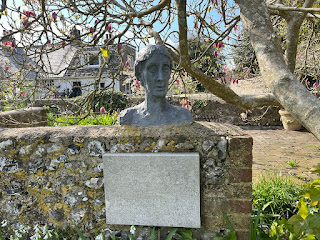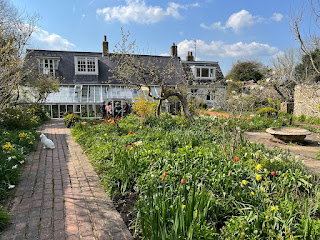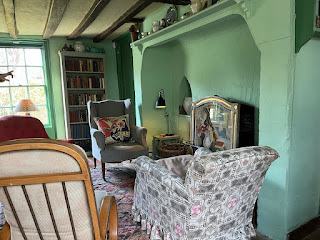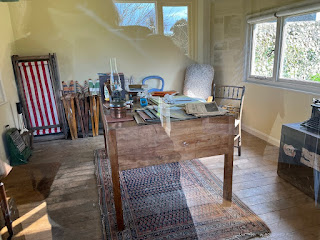Get ready, everyone - it's time for another National Trust Factoid. If you're a regular reader of this blog, you'll know that on several occasions during the National Trust Scone Odyssey I've had to stop the presses and put the scones down while I digest a mind-blowing factoid about the property I'm visiting.
Some of the National Trust Factoids I've shared are shocking - take, for example, the factoid that Dunwich Heath will have fallen into the sea by 2070. Some are very unexpected yet fascinating: Jimmy Page of Led Zeppelin fame opened one of the rooms at Knightshayes, as he is a big fan of the architect. And some are just bonkers: one former owner of Attingham had a working model of Vesuvius.
Today's factoid comes from the guidebook at Alfriston Clergy House in East Sussex. It turns out that the village of Alfriston inspired the hymn Morning Has Broken, which was written in 1931 by Eleanor Farjeon and was probably sung in primary school by every single person in the UK who is currently over the age of 40. Luckily for me, my primary school teacher preferred to play the Cat Stevens/Yusuf Islam version of Morning Has Broken, rather than let a bunch of 9-year-olds howl along to it, so it was Cat/Yusuf's very calming version that played constantly in my head as I wandered around the village.

Anyway. I was delighted to finally see Alfriston Clergy House today. I've been wanting to visit for 10 years because - and here's another factoid for you - it was the very first building that the National Trust took on in 1896 and I knew it would be fascinating. But I was also aware that it didn't have a cafe on site, so until now my ruthless pursuit of scones meant I had to focus on other places first.
 |
After waiting 10 years to visit, I coincidentally turned up on 15th April -
the day before Alfriston's 127th anniversary as the first NT building. |
But having now completed my scone odyssey, I'm free to go crazy and visit all the National Trust properties that don't serve refreshments. I did find today's outing a bit weird - I looked around the building, chatted to the guides, bought a guide book and a mug, and then casually decided I might as well have a cup of tea in the non-NT cafe across the green. There was no Scone Stress ("Do they sell scones?? Are there any scones left?? Are they good scones?? Why am I putting myself through this torment??") although I will admit I missed the stress a bit.
But let me crack on and tell you about Alfriston Clergy House:
The Clergy House is built between 1370-1450
Nobody knows who built Alfriston Clergy House or when it was built, but it was a timber-framed medieval building that was typical of the area, with a Hall, family rooms, and servants' quarters. It was extended in Tudor times, possibly to accommodate a married vicar and his family.
 |
| The Hall at Alfriston Clergy House |
Alfriston declines from the 17th century
The first recorded vicar to live in the house was Hugh Walker who arrived in 1593. The last vicar who resided there was Robert North who left in 1709. The area had prospered during the 15th century but it soon declined and was not a good living - this meant that vicars were often absentees living elsewhere.
The Clergy House is earmarked for demolition
After 1709, the house was rented out to non-clergy tenants. By 1841, there were 11 people living there - mainly the families of agricultural labourers. After the final resident died in 1883, the house became virtually derelict and permission was given to demolish the place.
 |
The Bedroom - set out as Harriet Coates, the last pre-NT tenant, likely had it
|
Rev Frederick Beynon saves the dayThankfully, demolition was prevented thanks to Rev Beynon, who became vicar of Alfriston in 1889. He appreciated the building's historic value, as well as seeing its potential as a possible location for a night school or other community use. He began to seek advice on how the place could be restored but he met with a lot of derision and discouragement.
The newly formed National Trust steps in
In 1894, the Society for the Protection of Ancient Buildings (SPAB) advised Beynon to speak to the council of what would shortly become the National Trust. The Trust had originally been focused on protecting open spaces - after some debate they agreed to take on Alfriston as their first building, completing the purchase in 1896. It was a struggle to raise the funds for restoration. The brilliant volunteer guide told me how the survival of the National Trust back then depended on the success of the Alfriston Clergy House project - if the latter had failed, the National Trust could have failed with it. (I didn't want to appear selfish or shallow so I didn't say "and I wouldn't have had 244 National Trust scones or been interviewed by Phillip Schofield on This Morning!" but it was what I was thinking.)
 |
Thank God for the National Trust.
This is what they took on in 1896 to restore it and save it from demolition. |
The NT lets the property to tenants
Once the purchase was complete, restoration got underway and the NT let the house to a series of tenants. The longest tenancy was Sir Robert Witt, a solicitor with a passion for art. He co-founded the Courtauld Institute and was a trustee of the Tate and the National Gallery. The garden was acquired in 1950 and the building fully opened to the public in 1977.
Scones make a surprise appearance!
I wasn't being completely honest earlier when I told you there was no Scone Stress today. On my previous visits, the sight of a cafe serving scones brought me huge relief and joy. Today's stress was inverted: having gone on national TV to tell everyone that I'd eaten a scone at every National Trust property that sells them, I carried terror in my heart that I'd walk round the corner and find an NT cafe at Alfriston.
Luckily for me, I didn't find an NT cafe (although there is a very friendly non-NT coffee shop across the green called The Gun Room). But I did give a little cheer for this stunt scone that I found in the Parlour, bravely teetering on the edge of a plate:
 |
National Trust stunt scone seen bravely doing its thing in the Parlour.
|
I become a founder member of the BYOSS (Bring Your Own Scone Society)
I had decided to make Alfriston my very first BYOS (Bring Your Own Scone) outing. This was for two reasons: firstly, to prevent Scone Withdrawal Symptoms in places where there is no NT cafe. Secondly, I absolutely love the Lemon & Coconut recipe from the National Trust Book of Scones and decided to bake some for my spring day out. Unfortunately, I overdid it with the lemon juice and forgot that wet scone dough doesn't rise. BUT - it was extremely tasty:
 |
The Lemon & Coconut Scone from the National Trust
Book of Scones. Verdict on my bake: flat but delicious. |
If I'm being honest about my Scone Sommelier skills, I'm not sure Lemon & Coconut was the right pairing for a medieval clergy house. I can't imagine there were a lot of lemons or coconuts knocking around the place in 1370. But nevermind! Onwards to the next outing!
Alfriston Clergy House: 5 out of 5
Scones: The quest is officially complete, so no more scone scoring required for properties that don't serve them!











